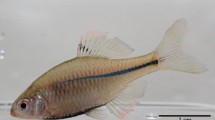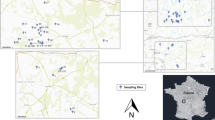Abstract
Whether environmental DNA (eDNA) testing methods are effective for semi-aquatic organisms that spend time both in rivers and on land remains unclear. We designed a species-specific primer–probe set for the semi-aquatic Japanese water shrew, Chimarrogale platycephala, an endangered top predator species for which limited ecological information is available. The designed primer–probe set was used to determine the effective sampling time for detecting eDNA from this species in running water. Hourly water sampling was conducted for 25 h in the autumn of 2020. Water sampling and camera trapping were conducted in the two streams in which feces had been observed on stream rocks. No C. platycephala activity was captured by the camera traps at any sampling point during the investigation. However, eDNA was mainly detected at night in both streams and twice during the daytime in one stream; the eDNA detection periods differed between streams (21:00–23:00 vs. 1:00–8:00 and daytime). These results demonstrate that eDNA testing methods are effective for detecting small semi-aquatic mammals. However, the sampling time affected the results, and eDNA was mostly detected at night, possibly because of the nocturnal activity of the species. Therefore, the sampling time should be adjusted to match the activity period of a species to improve the efficiency of eDNA testing for semi-aquatic organisms.



Similar content being viewed by others
References
Abe H (2003) Trapping, habitat, and activity of the Japanese water shrew, Chimarrogale platycephala. Honyurui Kagaku (mammal Sci) 43:51–65 (in Japanese)
Abe H (2011) Stomach contents of the Japanese water shrew, Chimarrogale Platycephala. Honyurui Kagaku (mammal Sci) 51(2):311–313 (in Japanese)
Bista I, Carvalho GR, Walsh K, Seymour M, Hajibabaei M, Lallias D, Christmas M, Creer S (2017) Annual time-series analysis of aqueous eDNA reveals ecologically relevant dynamics of lake ecosystem biodiversity. Nat Commun 8(1):14087. https://doi.org/10.1038/ncomms14087
Buchler ER (1976) A chemiluminescent tag for tracking bats and other small nocturnal animals. J Mammal 57(1):173–176
Bustin SA, Benes V, Garson JA, Hellemans J, Huggett J, Kubista M, Mueller R, Nolan T, Pfaffl MW, Shipley GL, Vandesompele J, Wittwer CT (2009) The MIQE guidelines: Minimum information for publication of quantitative real-time PCR experiments. Clin Chem 55(4):611–622. https://doi.org/10.1373/clinchem.2008.112797
Doi H, Katano I, Sakata Y, Souma R, Kosuge T, Nagano M, Ikeda K, Yano K, Tojo K (2017) Detection of an endangered aquatic heteropteran using environmental DNA in a wetland ecosystem. Roy Soc Open Sci 4(7):170568. https://doi.org/10.1098/rsos.170568
Doi H, Inui R, Matsuoka S, Akamatsu Y, Goto M, Kono T (2021) Estimation of biodiversity metrics by environmental DNA metabarcoding compared with visual and capture surveys of river fish communities. Freshw Biol 66(7):1257–1266. https://doi.org/10.1111/fwb.13714
Ficetola GF, Miaud C, Pompanon F, Taberlet P (2008) Species detection using environmental DNA from water samples. Biol Lett 4(4):423–425. https://doi.org/10.1098/rsbl.2008.0118
Flitcroft R, Cooperman MS, Harrison IJ, Juffe-Bignoli D, Boon PJ (2019) Theory and practice to conserve freshwater biodiversity in the Anthropocene. Aquat Conserv Mar Freshw Ecosyst 29(7):1013–1021. https://doi.org/10.1002/aqc.3187
Fujimoto R, Ando M, Ogawa H (2011) Efficient capture methods for the Japanese water shrew Chimarrogale platycephala. J Agric Sci Tokyo Univ Agric 55(4):290–296 (in Japanese)
Fukumoto S, Ushimaru A, Minamoto T (2015) A basin-scale application of environmental DNA assessment for rare endemic species and closely related exotic species in rivers: a case study of giant salamanders in Japan. J Appl Ecol 52(2):358–365. https://doi.org/10.1111/1365-2664.12392
Goldberg CS, Strickler KM, Pilliod DS (2015) Moving environmental DNA methods from concept to practice for monitoring aquatic macroorganisms. Biol Conserv 183:1–3. https://doi.org/10.1016/j.biocon.2014.11.040
Harper LR, Lawson Handley L, Hahn C, Boonham N, Rees HC, Gough KC, Lewis E, Adams IP, Brotherton P, Phillips S, Hänfling B (2018) Needle in a haystack? A comparison of eDNA metabarcoding and targeted qPCR for detection of the great crested newt (Triturus cristatus). Ecol Evol 8(12):6330–6341. https://doi.org/10.1002/ece3.4013
Harper LR, Lawson Handley LL, Carpenter AI, Ghazali M, Di Muri C, Macgregor CJ, Logan TW, Law A, Breithaupt T, Read DS, McDevitt AD, Hänfling B (2019) Environmental DNA (eDNA) metabarcoding of pond water as a tool to survey conservation and management priority mammals. Biol Conserv 238:108225. https://doi.org/10.1016/j.biocon.2019.108225
Ichikawa A, Nakamura H, Yoshida T (2005) Mark-recapture analysis of the Japanese water shrew Chimarrogale platycephala in the Fujisawa Stream, a tributary of the Tenryu River, central Japan. Mamm Study 30(2):139–143. https://doi.org/10.3106/1348-6160(2005)30[139:MAOTJW]2.0.CO;2
Kakuda A, Doi H, Souma R, Nagano M, Minamoto T, Katano I (2019) Environmental DNA detection and quantification of invasive red-eared sliders, Trachemy scripta elegans, in ponds and the influence of water quality. PeerJ 7:e8155. https://doi.org/10.7717/peerj.8155
Katano I, Harada K, Doi H, Souma R, Minamoto T (2017) Environmental DNA method for estimating salamander distribution in headwater streams, and a comparison of water sampling methods. PLoS ONE 12(5):e0176541. https://doi.org/10.1371/journal.pone.0176541
Kitagaki K (2016) Development of a device for outdoor recording of hunting behavior of Japanese water shrew, Chimarrogale platycephala. Nat Environ Sci Res 29:25–30 (in Japanese)
Lyet A, Pellissier L, Valentini A, Dejean T, Hehmeyer A, Naidoo R (2021) eDNA sampled from stream networks correlates with camera trap detection rates of terrestrial mammals. Sci Rep 11(1):11362. https://doi.org/10.1038/s41598-021-90598-5
Minamoto T, Miya M, Sado T, Seino S, Doi H, Kondoh M, Nakamura K, Takahara T, Yamamoto S, Yamanaka H, Araki H, Iwasaki W, Kasai A, Masuda R, Uchii K (2021) An illustrated manual for environmental DNA research: water sampling guidelines and experimental protocols. Environ DNA 3(1):8–13. https://doi.org/10.1002/edn3.121
Ministry of the Environment (2014) Red data book 2014. vol. 1 Mammals. Gyousei Tokyo
Miya M, Sato Y, Fukunaga T, Sado T, Poulsen JY, Sato K, Minamoto T, Yamamoto S, Yamanaka H, Araki H, Kondoh M, Iwasaki W (2015) MiFish, a set of universal PCR primers for metabarcoding environmental DNA from fishes: detection of more than 230 subtropical marine species. Roy Soc Open Sci 2(7):150088. https://doi.org/10.1098/rsos.150088
Motoki T (2000) New breeding method of the water shrew, Chimarrogale platycephala and the diurnal activity by using the new breeding apparatus. Ann Environ Sci Shinshu Univ 22:37–40 (in Japanese)
Ohdachi SD, Ishidashi Y, Iwasa MA, Fukui D, Saitoh T (eds) (2015) The wild mammals of Japan, 2nd edn. Shoukadoh, Kyoto, pp 16–18
R Core Team (2021) R: A language and environment for statistical computing. https://www.R-project.org/. R Foundation for Statistical Computing, Vienna, Austria
Rees HC, Maddison BC, Middleditch DJ, Patmore JRM, Gough KC (2014) The detection of aquatic animal species using environmental DNA—a review of eDNA as a survey tool in ecology. J Appl Ecol 51(5):1450–1459. https://doi.org/10.1111/1365-2664.12306
Saito H, Hashimoto H, Hino T, Motokawa M (2019) How does the Japanese water shrew Chimarrogale platycephalus cross the concrete walls of check dams? Mammal Study 44(1):1–11
Sekiya T, Ichiyanagi H, Tojo K (2017) Establishing of genetic analyses methods of feces from the water shrew, Chimarrogale platycephalus (Erinaceidae, Eulipotyphla). JSM Biol 2:1010
Takahara T, Minamoto T, Doi H (2013) Using environmental DNA to estimate the distribution of an invasive fish species in ponds. PLoS ONE 8(2):e56584. https://doi.org/10.1371/journal.pone.0056584
Takahashi MK, Meyer MJ, Mcphee C, Gaston JR, Venesky MD, Case BF (2018) Seasonal and diel signature of eastern hellbender environmental DNA. J Wild Manag 82(1):217–225. https://doi.org/10.1002/jwmg.21349
Takahashi S, Takada S, Yamanaka H, Masuda R, Kasai A (2021) Intraspecific genetic variability and diurnal activity affect environmental DNA detection in Japanese eel. PLoS ONE 16(9):e0255576. https://doi.org/10.1371/journal.pone.0255576
Thomsen PF, Willerslev E (2015) Environmental DNA–An emerging tool in conservation for monitoring past and present biodiversity. Biol Conserv 183:4–18. https://doi.org/10.1016/j.biocon.2014.11.019
Thomsen PF, Kielgast JOS, Iversen LL, Wiuf C, Rasmussen M, Gilbert MTP, Orlando L, Willerslev E (2012) Monitoring endangered freshwater biodiversity using environmental DNA. Mol Ecol 21(11):2565–2573. https://doi.org/10.1111/j.1365-294X.2011.05418.x
Togaki D, Doi H, Katano I (2020) Detection of freshwater mussels (Sinanodonta spp.) in artificial ponds through environmental DNA: a comparison with traditional hand collection methods. Limnology 21(1):59–65. https://doi.org/10.1007/s10201-019-00584-0
Uchii K, Doi H, Minamoto T (2016) A novel environmental DNA approach to quantify the cryptic invasion of non-native genotypes. Mol Ecol Resour 16(2):415–422. https://doi.org/10.1111/1755-0998.12460
Ushio M, Fukuda H, Inoue T, Makoto K, Kishida O, Sato K, Murata K, Nikaido M, Sado T, Sato Y, Takeshita M, Iwasaki W, Yamanaka H, Kondoh M, Miya M (2017) Environmental DNA enables detection of terrestrial mammals from forest pond water. Mol Ecol Resour 17(6):e63–e75. https://doi.org/10.1111/1755-0998.12690
Wood SA, Pochon X, Laroche O, von Ammon U, Adamson J, Zaiko A (2019) A comparison of droplet digital polymerase chain reaction (PCR), quantitative PCR and metabarcoding for species-specific detection in environmental DNA. Mol Ecol Resour 19(6):1407–1419. https://doi.org/10.1111/1755-0998.13055
Yamanaka H, Minamoto T, Matsuura J, Sakurai S, Tsuji S, Motozawa H, Hongo M, Sogo Y, Kakimi N, Teramura I, Sugita M, Baba M, Kondo A (2017) A simple method for preserving environmental DNA in water samples at ambient temperature by addition of cationic surfactant. Limnology 18(2):233–241. https://doi.org/10.1007/s10201-016-0508-5
Yamazaki H, Sekiya T, Nagayama S, Hirasawa K, Tokura K, Sasaki A, Ichiyanagi H, Tojo K (2020) Development of microsatellite markers for a soricid water shrew, Chimarrogale platycephalus, and their successful use for individual identification. Genes Genet Syst 95(4):201–210. https://doi.org/10.1266/ggs.20-00017
Yokohata Y, Kawada S, Ichiyanagi H (2008) A report on the workshop ‘Recent advances in the ecology and conservation of the Japanese water shrew, Chimarrogale platycephala’. Mamm Sci 48:175–176 (in Japanese)
Yonezawa S, Ushio M, Yamanaka H, Miya M, Takayanagi A, Isagi Y (2020) Environmental DNA metabarcoding reveals the presence of a small, quick-moving, nocturnal water shrew in a forest stream. Conserv Genet 21(6):1079–1084. https://doi.org/10.1007/s10592-020-01310-5
Acknowledgements
The present study was supported in part by JSPS KAKENHI Grants (15K00596 and 18K11678) to I.K. and by the Sasakawa Kagaku Research Grant (2021-5033) and JST SPRING, Grant No. JPMJSP2115 to N.S.
Author information
Authors and Affiliations
Contributions
All authors contributed to the study conception and design. Material preparation, data collection, and analysis were performed by MN, TS and HI, NS and IK, IK and HD, respectively. The first draft of the manuscript was written by IK and all authors commented on previous versions of the manuscript. All authors read and approved the final manuscript.
Corresponding author
Ethics declarations
Conflict of interest
The commercial affiliations of the authors [MN and TS] did not alter our adherence to the journal policies on the sharing of data and materials. MN and TS are employed by the company serving environmental assessments. However, none of the authors directly benefit financially from publication of this paper.
Rights and permissions
Springer Nature or its licensor holds exclusive rights to this article under a publishing agreement with the author(s) or other rightsholder(s); author self-archiving of the accepted manuscript version of this article is solely governed by the terms of such publishing agreement and applicable law.
About this article
Cite this article
Shiozuka, N., Katano, I., Doi, H. et al. Diurnal detection of environmental DNA of the semi-aquatic water shrew Chimarrogale platycephala using 25-h water sampling in streams. Landscape Ecol Eng 19, 69–77 (2023). https://doi.org/10.1007/s11355-022-00526-6
Received:
Revised:
Accepted:
Published:
Issue Date:
DOI: https://doi.org/10.1007/s11355-022-00526-6




